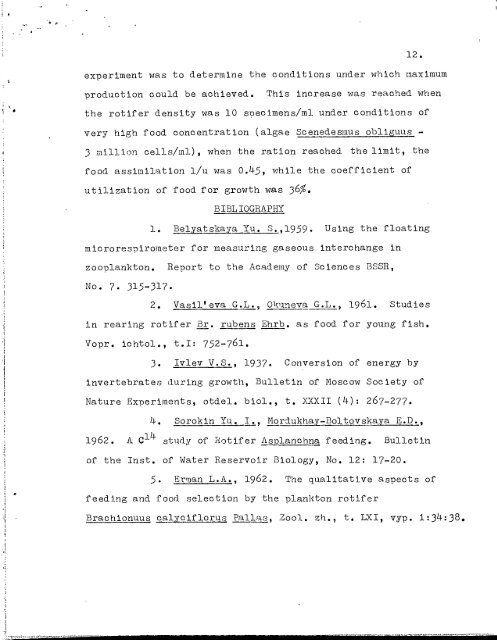Translation Series No.997
Translation Series No.997
Translation Series No.997
You also want an ePaper? Increase the reach of your titles
YUMPU automatically turns print PDFs into web optimized ePapers that Google loves.
f<br />
12.<br />
'•<br />
experiment was to determine the conditions under which maximum<br />
production could be achieved. This increase was reached when<br />
the rotifer density was 10 specimens/ml under conditions of<br />
very high food concentration (algae Scenedesmus obliguus<br />
3 million cells/ml), when the ration reached the limit, the<br />
food assimilation l/u was 0.45, while the coefficient of<br />
utilization of food for growth was 36%.<br />
BIBLIOGRAPHY<br />
1. Belyatskaya Yu. S.,1959. Using the floating<br />
microrespirometer for measuring gaseous interchange in<br />
zooplankton. Report to the Academy of Sciences BSSR,<br />
No. 7. 315-317.<br />
2. Vasireva G.L., Okuneva G.L., 1961. Studies<br />
in rearing rotifer Br. rubens Ehrb. as food for young fish.<br />
Vopr. ichtol., t.I: 752-761.<br />
3. Iviev V.S., 1937. Conversion of energy by<br />
invertebrates during growth, Bulletin of Moscow Society of<br />
Nature Experiments, otdel. biol., t. XXXII (4): 267-277.<br />
4. Sorokin Yu. I., Mordukhay-Boltovskaya E.D.,<br />
1962. A C 14 study of Rotifer Asplanchna feeding. Bulletin<br />
of the Inst. of Water Reservoir Biology, No. 12: 17-20.<br />
5. Erman L.A., 1962. The qualitative aspects of<br />
feeding and food selection by the plankton rotifer<br />
Brachionuus calyciflorus Pallas, Zool. zh., t. LXI, vyp. 1:34:38.
















